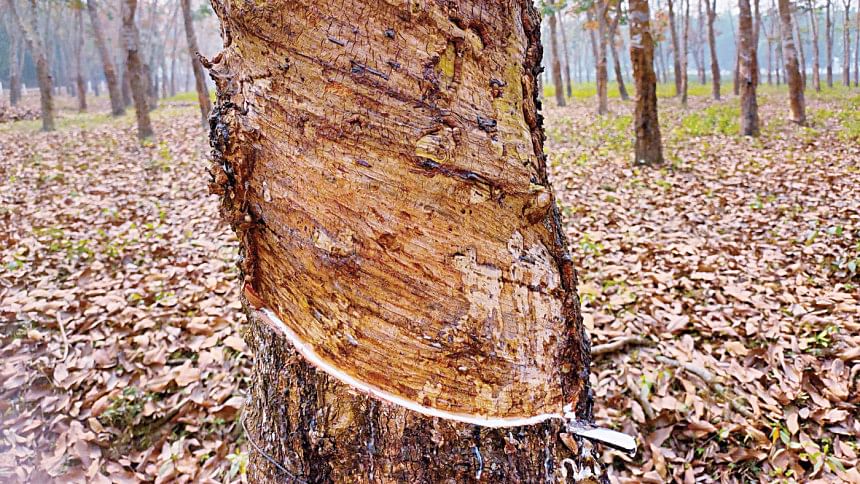Rubber growers worried over falling prices

Rubber growers in Bangladesh were left disappointed as their success in raising the production of the key material used in automobile and other industries has failed to fetch better prices owing largely to lower demand globally.
According to the Bangladesh Rubber Board (BRB) and rubber producers, 67,939 tonnes of latex were produced in the country last year, up 58 per cent from 43,000 tonnes in 2021, driven by an increase in the number of gardens and acreages under cultivation.
Latex is a sticky, milky and white colloid drawn off by making incisions in the bark and collecting the fluid in vessels. It is then refined into rubber for commercial processing.
But growers are upset as prices in the global market were lower.
According to Syed Moazzam Hossain, chairman of Lama Rubber Industry, rubber processors collect latex at Tk 150 per kilogramme while it was at least Tk 200 two years ago.
"Even, we sold raw rubber at Tk 350 per kg three to four years ago," he said.
Since raw rubber is perishable, it can't be preserved, Hossain said. "So, gardens have to sell raw rubber at a minimum price."
The cost of production for one kg of rubber in Bangladesh is between $0.63 and $0.84, industry people say.
In its recent analysis, Helixtap Technologies, which provides artificial intelligence-driven price and market intelligence for the rubber industry, said global rubber prices tend to move in tandem with global GDP growth or car production.
Global growth is projected to fall from an estimated 3.4 per cent in 2022 to 2.9 per cent in 2023, said the International Monetary Fund in January.
While car sales are expected to increase in 2023, it is likely expected to be below 2019 levels. Global vehicle miles driven are also likely to trend downwards this year should an increase in crude price materialise and such a trend would affect demand for replacement tyres, Helixtap said.
The demand for rubber reduced in the last three years due to lower sales in the automobile sector globally owing to the fallout of Covid-19 and the Russia-Ukraine war, according to the firm.

In Bangladesh, the demand for rubber is increasing in line with economic development as it is used in the manufacturing of tyres and tubes in the automotive sector, which is growing rapidly.
Currently, rubber is being grown on 140,000 acres of land with private operators running 1,304 gardens and state agencies operating 28 gardens. Most of the gardens are in the greater Chattogram region.
The size of the local raw rubber market is around Tk 1,020 crore, Hossain said.
Although no accurate data was available, garden owners have invested at least Tk 2,500 crore to establish the gardens, which have created around 150,000 jobs directly.
"The production of rubber has increased as new gardens have started production in different parts of the country," said Mohammad Kamal Uddin, a former president of the Bangladesh Rubber Garden Owners' Association.
"We are providing training to garden owners and workers and monitoring gardens closely, so the production has gone up," said Syeda Sarwar Jahan, chairman of the BRB.
She says the BRB is importing high-yield varieties from India and Malaysia to give a boost to production. The cultivation of local varieties has also increased thanks to higher fertiliser use and proper care.
"Garden owners have realised how to raise production."
Samir Datta Chakma, president of the Indigenous Rubber Garden Owners Association in Khagrachhari, says rubber producers don't get a reasonable price.
Rubber gardening in the hilly district is getting popular as it requires low investment but gives a long-term return.

According to him, there are more than 100 entrepreneurs who have established rubber gardens on around 3,500 acres of land in the district.
Chakma demanded access to finance for gardeners for the further expansion of the rubber-growing industry. The use of rubbers grown in the country has increased.
For example, locally produced rubbers account for at least 80 per cent of the ingredients needed to make sandals, said Arfanul Hoque, head of retail of Bata Shoe Company (Bangladesh), earlier.
Meghna Group is one of the users and exporters of rubber products.
Meghna Innova Rubber Co. Ltd, a concern of the group that exports bicycle tyres and tubes, uses 100 per cent locally produced rubber, said Luthful Bari, director for operations at Meghna Group.
Md Shahidul Islam, chairman of the Bangladesh Forest Industries Development Corporation, says the government agency exports rubber to India directly. This year, the shipment was insignificant as local demand is high.
"Besides, the export price is lower than that of in the domestic market."
Rubber exports fetched $46.8 million in the last fiscal year, the highest on record and up 37 per cent year-on-year, data from the Export Promotion Bureau showed.
The earnings from rubber shipment, however, declined 38 per cent to $17.86 million in the July-January period of the ongoing financial year. It was $28 million in the identical seven-month period of the previous year.

 For all latest news, follow The Daily Star's Google News channel.
For all latest news, follow The Daily Star's Google News channel. 






Comments